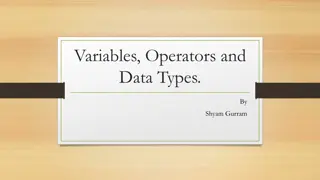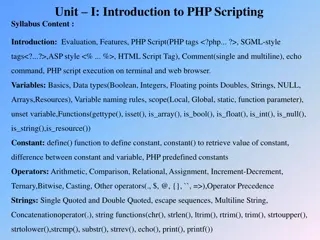
Understanding PHP Arrays: Types and Examples
Uncover the concept of PHP arrays and their types - indexed, associative, and multidimensional arrays. Learn how to create and manipulate arrays in PHP with detailed examples and illustrations. Dive into traversing and determining the length of indexed arrays, along with insights on associative arrays for enhanced data management in PHP programming.
Download Presentation

Please find below an Image/Link to download the presentation.
The content on the website is provided AS IS for your information and personal use only. It may not be sold, licensed, or shared on other websites without obtaining consent from the author. If you encounter any issues during the download, it is possible that the publisher has removed the file from their server.
You are allowed to download the files provided on this website for personal or commercial use, subject to the condition that they are used lawfully. All files are the property of their respective owners.
The content on the website is provided AS IS for your information and personal use only. It may not be sold, licensed, or shared on other websites without obtaining consent from the author.
E N D
Presentation Transcript
Beginning with PHP programming Presented by Mrs. RautAarti P. Assistant Professor Department of Comp. Sci. & IT. Deogiri College, Aurangabad
What is Array? Array variables are "special" because they can hold more than one value in one single variable. This makes them particularly useful for storing related values. An array stores multiple values in one single variable. Array is a collection of homogenous data item. We can access the values by referring to an index number. In PHP, the array() function is used to create an array: Syntax: array();
PHP Array Types There are 3 types of array in PHP. 1)Indexed Array: Arrays with a numeric index 2)Associative Array: An array where each key is associated with a value. 3)Multidimensional Array:Arrays containing one or more arrays
1)PHP Indexed Array PHP index is represented by number which starts from 0. We can store number, string and object in the PHP array. All PHP array elements are assigned to an index number by default. There are two ways to define indexed array: 1st way: $season=array(10,20,30,40); 2nd way: $season[0]=10; $season[1]=20; $season[2]=30; $season[3]=40;
Traversing PHP Indexed Array We can easily traverse array in PHP using foreach loop. Eg: <?php $size=array("Big","Medium","Short"); foreach( $size as $s ) { echo "Size is: $s<br />"; } ?>
Count Length of PHP Indexed Array PHP provides count() function which returns length of an array. Eg: <?php $size=array("Big","Medium","Short"); echocount($size); ?>
PHP Associative Arrays Associative arrays are arrays that use named keys that you assign to them. The associative arrays are very similar to numeric arrays in term of functionality but they are different in terms of their index. Associative array will have their index as string so that we can establish a strong association between key and values. To store the salaries of employees in an array, a numerically indexed array would not be the best choice. Instead, we could use the employees names as the keys in our associative array, and the value would be their respective salary. PHP allows you to associate name/label with each array elements in PHP using => symbol.
Conti.. There are two ways to define associative array: 1st way: $salary=array("Sonoo"=>"550000","Vimal"=>"250000","R atan"=>"200000"); 2nd way: $salary["Sonoo"]="550000"; $salary["Vimal"]="250000"; $salary["Ratan"]="200000";
Eg: <?php $salary=array("Sonoo"=>"550000","Vimal"=>"250000"," Ratan"=>"200000"); echo "Sonoosalary: ".$salary["Sonoo"]."<br/>"; echo "Vimal salary: ".$salary["Vimal"]."<br/>"; echo "Ratan salary: ".$salary["Ratan"]."<br/>"; ?>
Traversing PHP Associative Array <?php $salary=array("Sonoo"=>"550000","Vimal"=>"250000"," Ratan"=>"200000"); foreach($salary as $k => $v) { echo "Key: ".$k." Value: ".$v."<br/>"; } ?>
PHP - Multidimensional Arrays PHP multidimensional array is also known as array of arrays It allows you to store tabular data in an array. A multidimensional array is an array containing one or more arrays. PHP multidimensional array can be represented in the form of matrix which is represented by row * column. PHP supports multidimensional arrays that are two, three, four, five, or more levels deep. Eg: $emp = array ( array(1,"sonoo",400000), array(2,"john",500000), array(3,"rahul",300000) );
Conti <?php $emp = array ( array(1,"sonoo",400000), array(2,"john",500000), array(3,"rahul",300000) ); for ($row = 0; $row < 3; $row++) { for ($col = 0; $col < 3; $col++) { echo $emp[$row][$col]." "; } echo "<br/>"; } ?>
Accessing Array Elements we can pick the value of an array element by accessing it. The accessed element value can be stored in a variable and used for a operation. Array element can be accessed by index or key. The syntax for accessing an array element in PHP is $var-Name=Array-Name[integer index | string key] Array-name is name of an array that already created. Integer Index or a string key must be passed to access an element enclosed in square parentheses. Index is passed when the array is created with index values. String key is passed when array is an associative array.
PHP Array Functions PHP provides various array functions to access and manipulate the elements of array. The important PHP array functions are given below. 1) PHP array() function PHP array() function creates and returns an array. It allows you to create indexed, associative and multidimensional arrays. Syntax: array array ([ mixed $... ] )
2) PHP array_change_key_case() function PHP array_change_key_case() function changes the case of all key of an array. Note: It changes case of key only. Syntax array array_change_key_case ( array $array [, int $case = C ASE_LOWER ] ) Eg: <?php $salary=array("Sonoo"=>"550000","Vimal"=>"250000","Ratan "=>"200000"); print_r(array_change_key_case($salary,CASE_UPPER)); ?>
3)PHP array_chunk() function PHP array_chunk() function splits array into chunks. By using array_chunk() method, you can divide array into many parts. Syntax array array_chunk ( array $array , int $size [, bool $preserv e_keys = false ] ) Example <?php $salary=array("Sonoo"=>"550000","Vimal"=>"250000","Rat an"=>"200000"); print_r(array_chunk($salary,2)); ?>
4) PHP count() function PHP count() function counts all elements in an array. Syntax int count ( mixed $array_or_countable [, int $mode = COUNT_NORMAL ] ) Example <?php $season=array("summer","winter","spring","autumn"); echocount($season); ?>
5) PHP sort() function PHP sort() function sorts all the elements in an array. Syntax bool sort ( array &$array [, int $sort_flags = SORT_REGULA R ] ) Example <?php $season=array("summer","winter","spring","autumn"); sort($season); foreach( $season as $s ) { echo "$s<br />"; } ?>
6) PHP array_reverse() function PHP array_reverse() function returns an array containing elements in reversed order. Syntax array array_reverse ( array $array [, bool $preserve_keys = false ] ) Example <?php $season=array("summer","winter","spring","autumn"); $reverseseason=array_reverse($season); foreach( $reverseseason as $s ) { echo "$s<br />"; } ?>
7) PHP array_search() function PHP array_search() function searches the specified value in an array. It returns key if search is successful. Syntax mixed array_search ( mixed $needle , array $haystack [, bo ol $strict = false ] ) Example <?php $season=array("summer","winter","spring","autumn"); $key=array_search("spring",$season); echo $key; ?>
8) PHP array_intersect() function PHP array_intersect() function returns the intersection of two array.It returns the matching elements of two array. Syntax array array_intersect ( array $array1 , array $array2 [, array $... ] ) Example <?php $name1=array("sonoo","john","vivek","smith"); $name2=array("umesh","sonoo","kartik","smith"); $name3=array_intersect($name1,$name2); foreach( $name3 as $n ) { echo "$n<br />"; } ?>





















